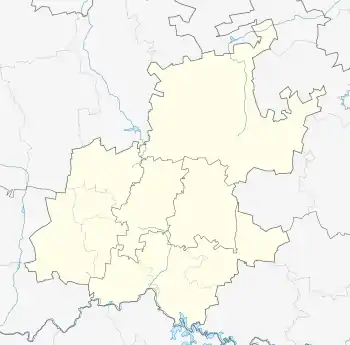Thembisa
Thembisa, formerly Tembisa, is a large township situated to the north of Kempton Park on the East Rand, Gauteng, South Africa. It was established in 1957 when black people were resettled from Alexandra and other areas in Edenvale, Kempton Park, Midrand and Germiston.
Thembisa township
Thembisa | |
|---|---|
 Thembisa township | |
 Thembisa township  Thembisa township | |
| Coordinates: 26.0055°S 28.2102°E | |
| Country | South Africa |
| Province | Gauteng |
| Municipality | Ekurhuleni |
| Established | 1957 |
| • Councillor | (ANC) |
| Area | |
| • Total | 42.80 km2 (16.53 sq mi) |
| Population (2011)[1] | |
| • Total | 463,109 |
| • Density | 11,000/km2 (28,000/sq mi) |
| Racial makeup (2011) | |
| • Black African | 98.9% |
| • Coloured | 0.2% |
| • Indian/Asian | 0.1% |
| • White | 0.1% |
| • Other | 0.7% |
| First languages (2011) | |
| • Northern Sotho | 33.1% |
| • Zulu | 21.7% |
| • Tsonga | 13.3% |
| • Xhosa | 7.0% |
| • Other | 24.9% |
| Time zone | UTC+2 (SAST) |
| Postal code (street) | 1632 |
| PO box | 1628 |
| Area code | 011 |
Etymology
The name Thembisa is a Nguni word meaning “promise” and “hope”, was later misspelled as Tembisa. When the settlement was founded, it carried a lot of hope and promise for a brighter future for its inhabitants. Though its initial residents were forcefully removed from parts of Kempton Park and Edenvale, for the purpose of clearing blacks from "white areas", settling in Thembisa also marked the end of years of harassment by apartheid authorities, and a reprieve from a life of squalor in their previous settlements.[2] Today Thembisa enjoys better infrastructure and its population has grown exponentially in the past 20 years, with its attraction being its location in the heart of Gauteng province's industrial zone.
The misspelling was corrected and the township renamed Thembisa in February 2020.[3]
History
The township was founded in 1957. After the Afrikaner-dominated National Party gained power in 1948 and began to implement apartheid, the pace of forced removals and the creation of townships outside legally designated white areas increased. The Johannesburg council established new townships for black people evicted from the city's freehold areas.
In 1956, townships were laid out for particular ethnic groups as part of the state's strategy to sift black people into groupings that would later form the building blocks of the so-called "independent homelands". It is the second largest township in Gauteng, following Soweto.
In 1977 the government initiated the Community Councils and in 1982 upgraded them to Town Councils, under the Black Local Authorities Act. The government vested limited powers on these councils but without financial muscle. Therefore, to raise revenue for purposes of developing the townships, the councils increased rent and service charges. This caused the residents in different townships, including Thembisa, to establish civic structures to resist the rent and service charge increases.[4]
In 2016, on July 25, residents were caught off guard when a tornado hit the area. The twister started in Kempton Park and moved over to Thembisa, causing the most destruction here. Around 20 individuals were seriously injured and in excess of 400 were left destitute. A standout amongst the most noticeable sights was the damage caused to the Phumulani Mall, where the rooftop crumbled after the tornado passed through it.
Transport
The township was not historically allowed to create employment centres within its area, so almost all of its residents commute daily to their employment destinations in places such as Kempton Park, Olifantsfontein, Pretoria, Johannesburg and Midrand.
Rail
Metrorail operates commuter trains between Thembisa and central Johannesburg. Train stations are Thembisa in the east, Limindlela in the center and Leralla in the west. Oakmoor and Olifansfontein stations are in the far east but is serviced by trains heading to Pretoria.
Taxi
Taxi's are used by most people to travel around Thembisa, South Africa and to neighbouring countries.
Notable people
- Lerato Chabangu - soccer player
- Panyaza Lesufi - Gauteng MEC for Education
- Tsietsi Mahoa -soccer player
- George Maluleka - soccer player
- Thabo Matlaba - soccer player
- Pearl Modiadie - TV presenter, radio DJ, producer
- Refiloe Nt'sekhe - Deputy Federal Chairperson of the Democratic Alliance (South Africa) (DA)
- Jerry Sikhosana former soccer player, most famously for Orlando Pirates F.C., coach
- Claude Tshidibi - rugby union player
- Mthokozisi Yende - soccer player
- Lady Zamar - singer, songwriter
- Themba Zwane - soccer player
References
- "Main Place Tembisa". Census 2011.
- "SAHA - South African History Archive - Establishment of Tembisa". www.saha.org.za. Retrieved 2018-05-03.
- Mbuli, Mbekezeli. "Tembisa to get missing 'h' back after years of misspelling". The Citizen. Retrieved 2020-09-04.
- "SAHA - South African History Archive - Tembisa in the 1980s - Civic structures". www.saha.org.za. Retrieved 2018-05-03.
.svg.png.webp)
